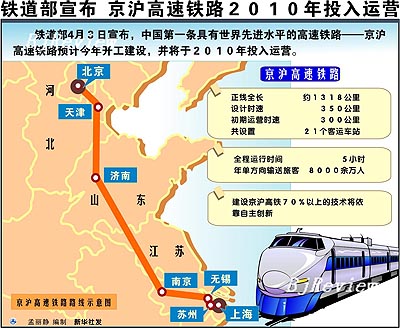|

After 10 years of evaluation and research, the high-speed railway between Beijing and Shanghai is finally under construction, according to Liu Zhijun, Minister of Railways, in Beijing.
With a total length of 1,318 km, the Beijing-Shanghai high-speed railway has a planned investment of 186.5 billion yuan ($24.87 billion) and is expected to complete for operation in 2011 after 52 months of construction. This realization of the high-speed railway meant to alleviate the pressure of north-south transportation in the coastal area of east China. At present, the density of railway transport between Beijing and Shanghai is four times the country's average and is always in a state of overload that cannot satisfy demand.
Now, preliminary preparations hav been launched and some bridges, such as the Nanjing Yangtze River Bridge, are under construction. By the end of this year, construction of some key roadbeds, bridges and tunnels will commence.
Independent technology
According to the Ministry of Railways (MOR), the design life of the high-speed railway between Beijing and Shanghai will be 100 years, with the maximum speed of 350 km per hour and an operating speed of 300 km per hour. Adopting a wheel/rail approach, the technology for the railway will be largely dependent on Chinese technology. Lines, bridges, tunnels and culverts will be constructed with completely independent technology standards and intellectual property developed by China.
Since the early 1990s, when China first proposed to build this high-speed railway, the international community has paid close attention to its development. Japan, France and Germany have been embroiled in intensive competition over construction contracts for the railway. Leaders of the three countries have all tried to persuade China to adopt their technologies, and fierce debate ensued in China over whether to use the wheel/rail approach of Japan and France, or the magnetic levitation train from Germany.
"China is completely capable of building the Beijing-Shanghai high-speed railway on its own," said Wang Yueming, researcher at the China Academy of Railway Sciences (CARS).
According to Wang, China is capable of manufacturing locomotives with their speed surpassing 350 km per hour, and there will be no problems for trains to be used in the high-speed railway. The Beijing-Shanghai train will adopt viaducts, preventing people from approaching the railway. This measure will save land and impose no influence on ground transport, ensuring the safety and the speed of the railway.
On September 12, construction of the National Engineering Laboratory of High-Speed Railway Systems under the CARS was approved by the National Development and Reform Commission (NDRC). This laboratory, focused on testing the reliability, safety, comfort, energy usage and environmental performance of high-speed railway systems, will establish testing and verification facilities for the comprehensive performance of high-speed railways, and create a support platform for relevant construction projects.
The Beijing-Shanghai high-speed railway will also adopt overseas high-speed railway technologies. According to Liu Zhijun, domestic technologies will account for 70 percent, while imported components to be assembled 20 percent and imported complete sets of components 10 percent. Imported technologies will mainly be used in signal systems.
Multiple financing channels
Investment of 90 billion yuan ($12 billion) has so far been approved for the project--half of what is needed for completion.
Wang Qingyun, Director of the Department of Communications of the NDRC, says that the state will establish the Beijing-Shanghai High-Speed Railway Co. Ltd. to actively explore market-oriented financing and absorb private and foreign capital, though Chinese investors will be the controlling shareholders.
He Huawu, Chief Engineer of the MOR, says that the enthusiasm aroused by the construction of the railway will attract diversified capital from both domestic and foreign capital markets so as to realize multiple investors, financing channels and financing methods.
| 